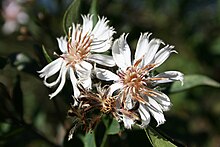
Asteraceae is a large family of flowering plants that consists of over 32,000 known species in over 1,900 genera within the order Asterales. The number of species in Asteraceae is rivaled only by the Orchidaceae, and which is the larger family is unclear as the quantity of extant species in each family is unknown. The Asteraceae were first described in the year 1740 and given the original name Compositae. The family is commonly known as the aster, daisy, composite, or sunflower family.

Grindelia (gumweed) is a genus of plants native to the Americas belonging to the family Asteraceae. The genus was named for Latvian botanist David Hieronymus Grindel, 1776–1836.

Calocephalus is a genus of flowering plants in the family Asteraceae. It is endemic to Australia, where it is represented in every state.
Cineraria deltoidea is a perennial flowering plant of the family Asteraceae and the genus Cineraria which is also the closest known relative of the giant Dendrosenecio of East Africa.

Liabeae is a tribe in the plant family Asteraceae. It is endemic to the Neotropics, where it is most diverse in the northern and central Andes. The center of diversity is in Peru.

Ageratina herbacea is a North American species of flowering plants in the family Asteraceae known by the common names fragrant snakeroot and Apache snakeroot. It is native to desert regions of the southwestern United States and northern Mexico. It grows in rocky slopes in conifer forests and woodlands.
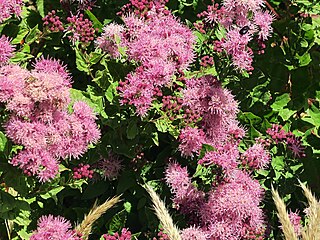
Ageratina occidentalis is a species of flowering plant in the family Asteraceae known by the common name western snakeroot or western eupatorium. It is native to the western United States where it grows in several types of habitat. It is found in California, Oregon, Washington, Idaho, Montana, Nevada, and Utah.
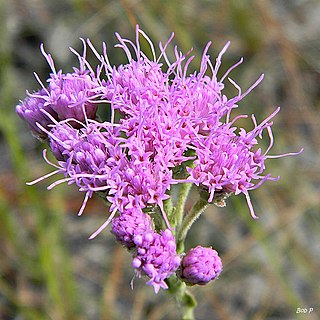
Carphephorus is a genus of North American plants in the family Asteraceae. They are native to the southeastern United States from Louisiana to Virginia. Plants of this genus are known commonly as chaffheads.

Carphochaete is a genus of North American flowering plants in the family Asteraceae. They are native to Mexico and the southwestern United States. They are known commonly as bristleheads.
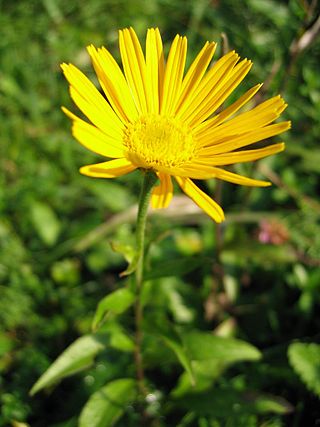
Buphthalmum is a genus of flowering plants in the aster family, Asteraceae. They are native to Europe, and B. salicifolium is in cultivation and has been introduced elsewhere.

Erigeron chrysopsidis var. austiniae is a species of flowering plant in the family Asteraceae known by the common name sagebrush fleabane. It is sometimes considered a full species, Erigeron austiniae. It is native to the western United States from northeastern California to southwestern Idaho, where it grows in the sagebrush and juniper woodlands. It is a small, clumping perennial herb producing a hairy stem up to about 12 centimeters tall from a woody caudex and taproot surrounded by narrow linear to somewhat oval leaves up to 8 centimeters long. The inflorescence is a solitary flat-topped woolly flower head containing many yellow disc florets. There occasionally appears a yellow ray floret, but they are usually absent. The fruit is an achene with a pappus of bristles.

Stenotus is a genus of flowering plants in the family Asteraceae. There are four species, all native to western North America. They are known commonly as mock goldenweeds.

Didelta is a genus of shrubs of up to 1 or 2 meter high, with two known species in the daisy family. Like in almost all Asteraceae, the individual flowers are 5-merous, small and clustered in typical heads, and are surrounded by an involucre, consisting of in this case two whorls of bracts, which are almost free from each other. The 3–5 outer bracts are protruding and triangular in shape, the inner about twice as many are lance-shaped and ascending. In Didelta, the centre of the head is taken by 3–5 clusters of bisexual yolk yellow disc florets, sometimes divided from each other by male disc florets, and is surrounded by one complete whorl of infertile yolk yellow ray florets. The common base of the flowerhead swells around the developing fruitlets, become woody and breaks into segments when ripe. The fruitlets germinate within this woody encasing. The species of the genus Didelta can be found in Namibia and South Africa. The genus is called salad thistle in English and slaaibos in Afrikaans.

Gochnatia is a genus of flowering plants in the daisy family, Asteraceae. It is named for botanist Frédéric Karl Gochnat. The genus contains mainly shrubs and subshrubs, with a few trees and herbs. All of the species are native to the American tropics. Two species native to the mountains of Southeast Asia and formerly included here are now separated as the genus Leucomeris in subfamily Wunderlichioideae.
Calostephane is a genus of flowering plants in the aster family, Asteraceae.
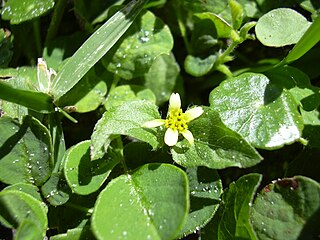
Calyptocarpus is a genus of flowering plants in the family Asteraceae.
Chiliophyllum is a monotypic genus of flowering plants in the aster family, Asteraceae, containing the single species Chiliophyllum densifolium. It is endemic to Argentina, where it is known only from Mendoza Province. Its local common names include romero del piche and romero pichi.
Chiliotrichiopsis is a genus of flowering plants in the family Asteraceae. It is native to the Andes, where it is distributed in Peru, Bolivia, and Argentina. Species occur in the mountains up to 4200 meters in elevation.
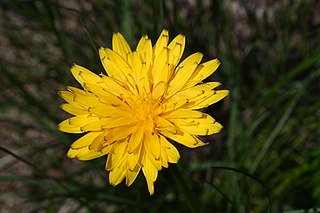
Nothocalais alpestris is a species of flowering plant in the family Asteraceae known by the common name alpine lake false dandelion. It is native to the Cascade Range, Sierra Nevada and other mountains from northern Washington to central California, where it grows in subalpine forests and meadows, most commonly at 1,200–2,700 m (4,000–9,000 ft) elevation.

Gamochaeta is a genus of flowering plants in the family Asteraceae. There has not always been agreement among botanists regarding its status as a recognized genus, but it has become more accepted in recent years. It currently includes many plants that previously belonged in genus Gnaphalium. Like many species of Gnaphalium, many Gamochaeta are called cudweeds or everlastings.
